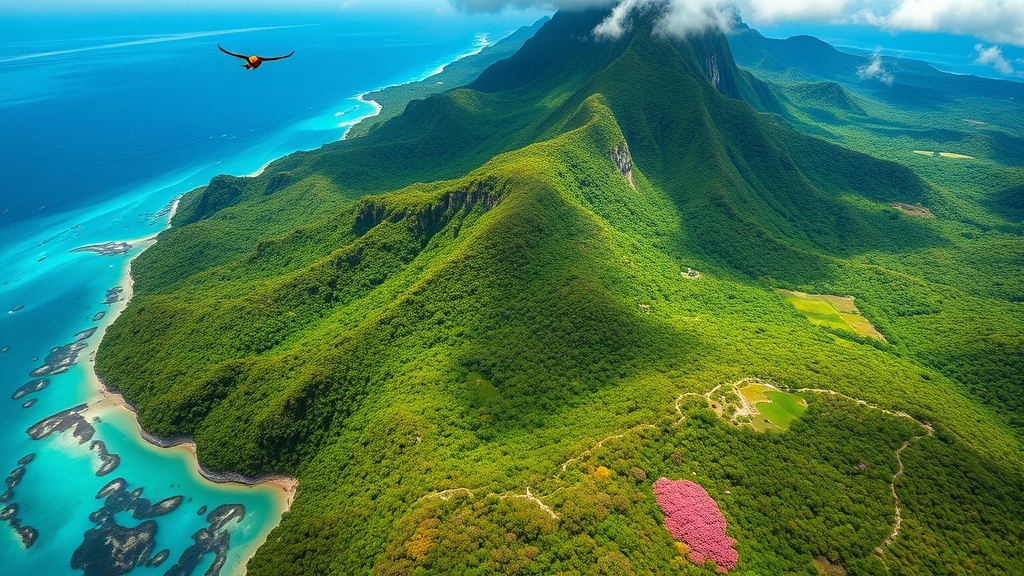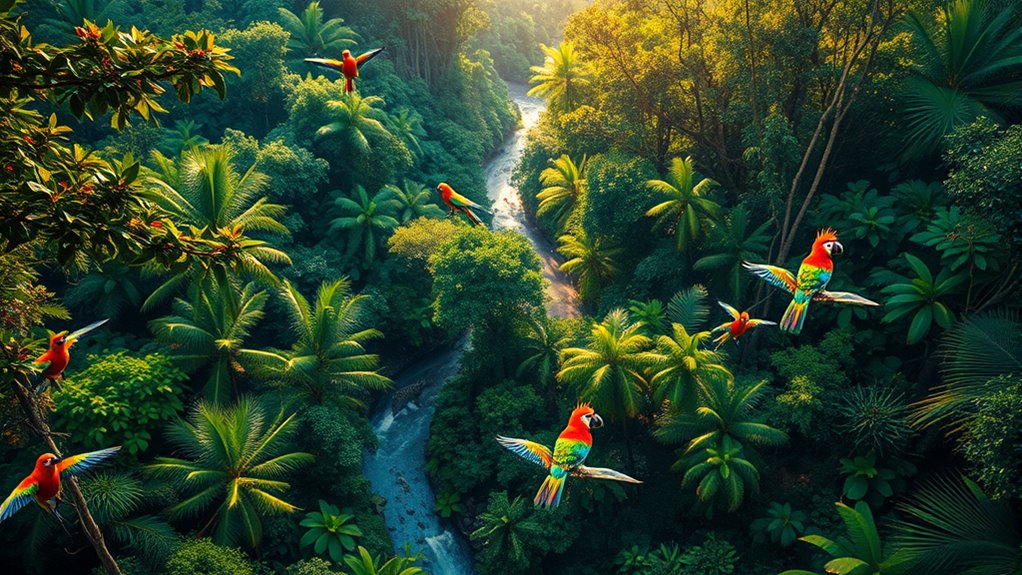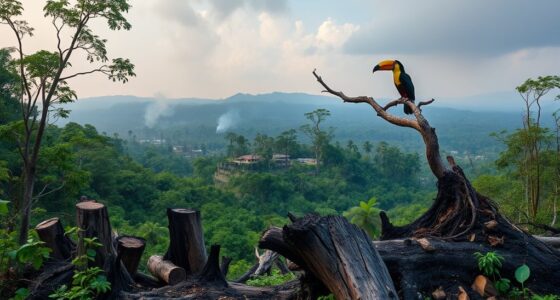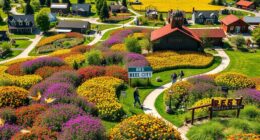Biodiversity hotspots around the world are regions with incredibly rich and unique plant and animal species found nowhere else. These areas, like the Amazon, Southeast Asian rainforests, and Madagascar, face threats from human activities such as deforestation, agriculture, and urban growth. Protecting these hotspots is essential for maintaining Earth’s ecological balance and supporting endemic species. If you’re curious about how conservation efforts work and which hotspots are most at risk, keep exploring to discover more.
Key Takeaways
- Biodiversity hotspots are regions with high endemic species richness that are critically threatened by human activities.
- There are 36 recognized biodiversity hotspots worldwide, including the Amazon, Himalayas, and Madagascar.
- Hotspots cover about 2.4% of Earth’s land surface but harbor over half of the world’s endemic plant species.
- Conservation efforts in these areas focus on habitat protection, restoration, and community involvement.
- Protecting hotspots is essential for global biodiversity preservation and ecological stability.

Biodiversity hotspots are regions teeming with an extraordinary variety of plant and animal species found nowhere else on Earth. These areas are essential to our planet’s ecological health, but they face constant threats from human activities like deforestation, agriculture, and urbanization. To protect these unique ecosystems, conservation strategies must be tailored specifically to each hotspot’s needs, focusing on preserving endemic species—those that exist only in that particular region. Endemic species are especially vulnerable because their limited distribution makes them more susceptible to extinction if their habitat is disturbed or destroyed. The role of high contrast ratios in projectors is crucial for accurately rendering detailed images, much like how preserving the fine details of endemic species ensures the integrity of the entire ecosystem.
When you think about conserving biodiversity hotspots, it’s necessary to understand that a one-size-fits-all approach doesn’t work. Instead, effective conservation strategies involve a combination of protected areas, community involvement, and sustainable practices. Establishing national parks or reserves helps safeguard critical habitats, but it’s equally important to involve local communities who depend on these lands for their livelihoods. By integrating conservation efforts with local needs, you can foster a sense of stewardship that encourages ongoing protection and sustainable use of resources. Additionally, understanding the specific ecological functions of endemic species can guide targeted conservation efforts to maintain ecosystem resilience.
Focusing on endemic species is essential because they often play essential roles within their ecosystems, such as pollination, seed dispersal, or maintaining soil health. Losing these species could trigger a cascade of ecological consequences, ultimately jeopardizing the entire hotspot. Conservation strategies should prioritize research and monitoring to better understand the specific needs of these endemic species, ensuring that habitat restoration and protection efforts are effective. For instance, restoring native vegetation or controlling invasive species can help create viable environments for these vulnerable organisms.
Another key aspect of conservation strategies involves raising awareness and educating local communities, policymakers, and visitors about the importance of biodiversity hotspots. When you’re informed about the unique species and the risks they face, you’re more likely to support policies that protect these regions. Promoting eco-tourism can also generate funds for conservation while providing economic benefits to local populations, making the effort sustainable in the long run. Incorporating community-based management approaches can further enhance local engagement and long-term success.
Ultimately, protecting biodiversity hotspots requires a proactive and adaptive approach. You need to continually assess threats, implement targeted conservation actions, and involve all stakeholders—from scientists to local residents—to guarantee that endemic species and the ecosystems they inhabit are preserved for future generations. By doing so, you help maintain the Earth’s rich biological heritage and contribute to global efforts to combat biodiversity loss. Recognizing the importance of ecosystem health ensures that conservation efforts are comprehensive and effective.
Frequently Asked Questions
How Are Biodiversity Hotspots Identified and Prioritized Globally?
You can see that biodiversity hotspots are identified by examining species richness and endemism patterns, which highlight areas with exceptionally high biodiversity and unique species found nowhere else. Researchers prioritize these regions based on the degree of habitat loss and ecological significance. By focusing on these criteria, you help guarantee conservation efforts target areas that support the most diverse and irreplaceable ecosystems, safeguarding species and habitats for future generations.
What Are the Main Threats to Biodiversity Hotspots?
You should know that the main threats to biodiversity hotspots include species extinction caused by habitat fragmentation and destruction. When habitats are broken into smaller pieces, many species struggle to survive, leading to declines and eventual extinction. Human activities like deforestation, agriculture, and urban development intensify these threats, making it harder for ecosystems to sustain their rich variety of life. Protecting these areas requires addressing habitat fragmentation and curbing harmful practices.
How Do Conservation Efforts Differ Across Hotspots?
Think of conservation efforts like a symphony, with each hotspot playing its own tune. You’ll find that strategies vary: some focus on community involvement, empowering locals to protect habitats, while others leverage eco-tourism benefits to fund preservation. In regions facing deforestation, stricter regulations are enforced. Overall, tailored approaches consider local needs and threats, ensuring each hotspot’s unique biodiversity gets the attention it deserves.
Can Biodiversity Hotspots Recover From Environmental Damage?
Biodiversity hotspots can recover from environmental damage, but it depends on the extent of harm and your conservation efforts. Restoration techniques like reforestation and habitat rehabilitation help restore ecosystems. Effective policy implementation is essential, as it enforces protective measures and reduces further damage. Your active involvement in supporting these strategies can make a difference, helping hotspots regain their rich biodiversity over time.
What Role Do Local Communities Play in Hotspot Conservation?
You play a crucial role in hotspot conservation by supporting local communities that use indigenous practices to protect their environment. Your involvement in eco tourism initiatives encourages sustainable tourism, which benefits these communities financially while preserving biodiversity. By choosing eco-friendly options and respecting local customs, you help promote conservation efforts, ensuring that ecosystems remain healthy and resilient. Your actions directly contribute to safeguarding the world’s most precious biodiversity hotspots for future generations.
Conclusion
So, congratulations! You now know about these precious biodiversity hotspots—places so valuable that we practically treat them like private clubs for endangered species. Maybe next time, instead of ignoring their cries, you’ll join the club of conservation. After all, if we keep taking from nature without giving back, these hotspots might just become the exclusive, extinct-only resorts of the future. Don’t say we didn’t warn you—your planet’s VIPs are counting on you.







